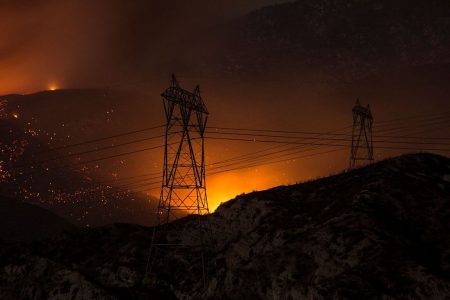January 21, 2019 – The wildfires that wiped out Paradise and other areas of California recently have claimed more than the peoples’ lives and homes lost in the fall. Pacific Gas & Electric (PG&E), the state’s largest utility, in the face of $7 billion USD in claims from the 86 who died, 500 businesses, 4,300 buildings and 14,000 homes all lost, has been a tipping point for the company. It announced it will file for bankruptcy on January 29, 2019.
Why is PG&E in the crosshairs of those making insurance claims for the damages caused by the Camp Fire, as innocuous a name as one can give to what turned out to be the most deadly wildfire event in California’s recent memory? Because it is alleged that the fire’s origin is linked to PG&E power lines coming in contact with trees. The company had reported a transmission outage in the area 15 minutes before the fire began. The suspect downed power line was near PG&E poles riddled by bullet holes with the line itself entangled in tree branches.
This isn’t the first PG&E brush with wildfires attributed to their infrastructure failures. Wildfires in the state in 2017 which caused 44 deaths and $10 billion in damages were blamed on the company because as investigators reported, PG&E had failed to meet code requirements in clearing brush from around power lines.
PG&E in its filing claims that it has insufficient funds to meet the $7 billion in claims with only about $1.5 billion in cash or equivalents on hand. Hence the bankruptcy filing to get relief from creditors.
In an article appearing in MarketWatch, from The Wall Street Journal, published on January 18, 2019, it describes the bankruptcy filing as “the first major corporate casualty of climate change.” It appears that PG&E faces 750 lawsuits amounting to $30 billion in liabilities from wildfires attributed to power lines running through the state’s forested landscape which bring electricity to approximately 5.2 million households in central and northern California.
So why attribute PG&E’s plight to climate change as The Wall Street Journal has claimed? Because California has experienced severe drought through much of the last decade which has left forests with millions of dead trees and underbrush, kindling lying around for the next spark. The drought may or may not be out of the norm for the state based on historic climatological evidence. But the intensity of the drought combined with communities encroaching on California’s wildlands has become a recipe for impending disaster. PG&E has neither the manpower or the resources to keep up with the growing challenges faced by California’s drying up forests.
California’s laws put the responsibility squarely on the back of the company to reduce fire infrastructure risk in areas where it operates. With wildfires a chronic problem in California with the state describing the annual crisis in a new representation of the four seasons, adding a fifth, fire season, to the repertoire, it is clear that the potential demise of PG&E requires the state as well as utilities to develop wildfire mitigation policy and actions that reflect the changing climate environment.
PG&E has made significant investments in renewable energy fed to the grid as well as power-purchase agreements with homeowners with installed solar panels where the utility buys back surplus power from these providers to feed the grid. For power-sharing contracts, the bankruptcy filing could put them in jeopardy.
But there is a technology solution for California and other jurisdictions facing the challenges of grid infrastructure versus impacts from climate change-induced extreme events like these wildfires. What is the solution?
Development of microgrid distributed energy infrastructure eliminates tens of thousands of kilometers of power lines running through densely forested wildlands. Both the state and its utilities need to consider de-energizing the power lines and replacing long-distance power transmission with micro-clustered energy generation and distribution that is confined to a small geographic footprint.
A second solution for California would be to stop allowing the encroachment of communities into wildland areas. Paradise was literally carved out of California wildlands. This type of creeping urban development makes climate change mitigation and adaptation that much more difficult and costly in lives, material losses, and the liability earned by companies like PG&E.
The reinsurance industry tracks claims related to extreme weather events associated with climate change. There are no climate change deniers in the offices of these companies. Munich Re, Swiss Re, Lloyds of London, and other reinsurers are unanimous in their assessment of what is happening around the world from changing climate. They do the math and can discern the difference between the expected and unexpected losses that allow them to underwrite insurance companies’ policies. Their risk models show that places like California are central casting for climate change. That the wildfires are the first alerts of global warming induced by rising atmospheric carbon dioxide and other greenhouse gases.
Munich Re has compiled the largest database of natural disasters and can attribute which are climate change related. The company has been warning governments for years about the attendant risk. And what makes matters worse is situations like California where people are building communities with expensive homes in areas encroaching on wildlands. They are taking out insurance coverage which the people at Munich Re will tell you is becoming increasingly costly, a recipe for economic disaster that leads to companies like PG&E being forced into bankruptcy protection.









